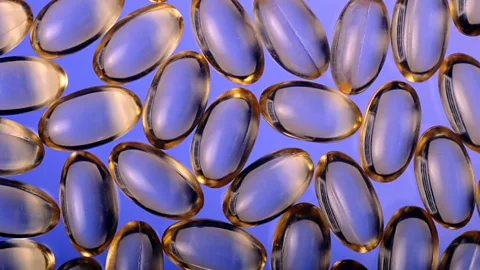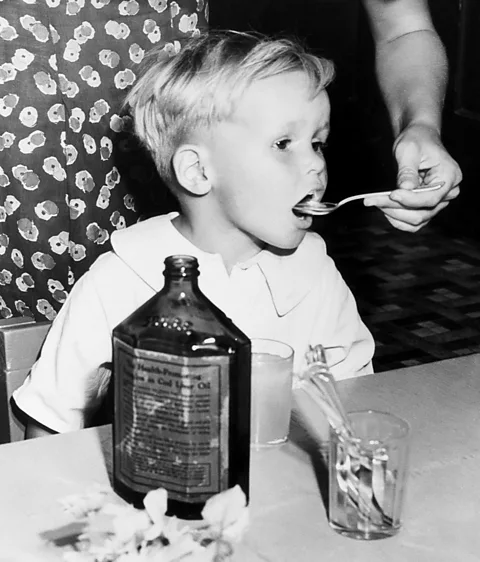Cod liver oil: A fishy fix that had surprisingly clear health benefits
 Getty Images
Getty ImagesWhen many people struggled to eat a healthy diet, odd-tasting oils were touted as a fix-all. It turns out one of them did indeed pack a vitamin punch.
These days, the words "cod liver oil" are vaguely sepia-tinged. They conjure up an image of a murky spoonful of something, brandished by a school nurse or a Dickensian headmaster.
So many remedies from the 18th and 19th Centuries have not stood the test of time. We no longer, for instance, routinely give crying babies opiates. Syrup of figs and castor oil are no longer considered cure-alls, though they take care of constipation perhaps a little too well. And when was the last time you stopped by the chemist's for brimstone and treacle?
But cod liver oil is one of those rare remedies from the age of snake oil and patent medicine that actually had something to it. Made from heating the livers of codfish and catching the oil that leaks out, the stuff is fantastically rich in vitamin D and vitamin A. Before the discovery of vitamins – that would have to wait a few more years – people had noticed that children dosed with cod liver oil were less likely to develop rickets, the childhood bone disease from which the term "rickety" is derived and which can cause seizures and heart attacks.
 Getty Images
Getty ImagesThe discovery in 1919 that calcium deficiency and vitamin D deficiency were behind rickets explained the tonic's surprising power. During World War Two, the UK government issued free cod liver oil to children under the age of five. "Don't forget Jimmy's orange juice & cod liver oil!" exhorted one contemporary poster.
Cod liver oil, whatever its other qualities, was often an unpleasant thing to swallow. Like any oil, contact with oxygen can make it go rancid, yielding a foul fishy taste. But what seemed like another, less off-putting way to get vitamin D – sitting in the Sun and letting enzymes under the skin's surface take care of its manufacture – was routinely not an option for children in the UK, a fact that remains as true today as it was a hundred years ago. (And it's likely to get worse, as the Met Office predicts winters getting 30% rainier than they were in 1990 by 2070.)
So, decades ago, many governments turned to fortifying foods. In 1940, the UK began mandatory fortification of margarine with vitamin D. Bread, milk, and breakfast cereal manufacturers joined in. In the US, fluid milk has been fortified with vitamin D by law since 1933, and breakfast cereals, bread and flour are all routinely, if voluntary, fortified. Even in the 21st Century, governments have changed policy to try to raise levels of vitamin D: Finland introduced its own voluntary fortification plan in 2003, with near-universal participation from food manufacturers.
But fortification efforts in the UK hit a roadblock early on. Cases of a disease called hypercalcaemia, in which excess calcium in the blood forms kidney stones and causes other problems, were discovered after fortification began. That led experts to suspect that kids were overdosing on vitamin D. Fortification was banned in the 1950s, with the exceptions of margarine and baby formula.
 Getty Images
Getty ImagesYet cod liver oil did not appear to make a comeback. In 2013, the UK discontinued the fortification of margarine, with the stated intention of encouraging people to take supplements instead (few people heeded, or were perhaps even aware of, this advice). And in recent years, as blood tests for vitamin D levels have improved, some startling truths have come to light. Between January and March, when sunlight is at an all-time low, an enormous fraction of children – nearly 40% in some age groups – in the UK are deficient in vitamin D. Nearly 30% of adults are in the same situation. People with darker skin are at particular risk. "Low vitamin D status is almost universal in the UK South Asian population," wrote public health nutritionist Judith Buttriss of the Academy of Nutrition Science in an editorial in the journal Nutrition Bulletin.
What's more, rickets is back. Hospital admissions for rickets in the UK were low in the 60s and 70s and dropped further in the following decades. In 1991, statistically, there were 0.34 cases of rickets per 100,000 people under the age of 15 in England. But in the 2000s, rates began to rise, even skyrocket. "Hospitalisation rates for rickets in England are now the highest in five decades," wrote scientists in 2011.
More like this:
• The rise and fall and possible rise of the oyster
Is it time for fortification to make a comeback? The UK's Scientific Advisory Committee on Nutrition is considering the question: it is now thought that the cases of hycercalcaemia that scuppered fortification in the UK were due to a genetic disease that interfered with the vitamin's absorption. In other words, eating too many fortified foods was not necessarily the problem. Perhaps a change lies ahead.
There are likely a number of factors behind the rise of rickets in the UK. But it does suggest that something like the spoonful of cod liver oil might make a return.
--
If you liked this story, sign up for The Essential List newsletter – a handpicked selection of features, videos and can't-miss news, delivered to your inbox twice a week.
For more science, technology, environment and health stories from the BBC, follow us on Facebook and X.
